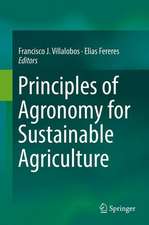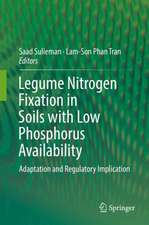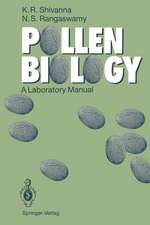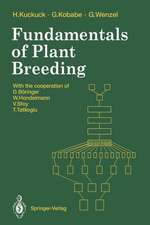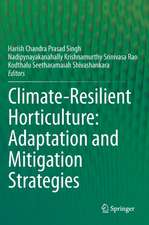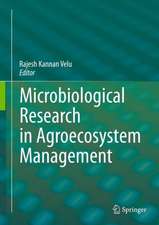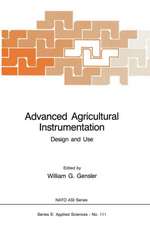Crop Yield: Physiology and Processes
Editat de Donald L. Smith, Chantal Hamelen Limba Engleză Paperback – 12 noi 2013
Preț: 900.80 lei
Preț vechi: 1098.53 lei
-18% Nou
Puncte Express: 1351
Preț estimativ în valută:
172.41€ • 179.32$ • 144.48£
172.41€ • 179.32$ • 144.48£
Carte tipărită la comandă
Livrare economică 13-27 martie
Preluare comenzi: 021 569.72.76
Specificații
ISBN-13: 9783642636448
ISBN-10: 3642636446
Pagini: 524
Ilustrații: XVI, 504 p. 61 illus.
Dimensiuni: 155 x 235 x 28 mm
Greutate: 0.73 kg
Ediția:Softcover reprint of the original 1st ed. 1999
Editura: Springer Berlin, Heidelberg
Colecția Springer
Locul publicării:Berlin, Heidelberg, Germany
ISBN-10: 3642636446
Pagini: 524
Ilustrații: XVI, 504 p. 61 illus.
Dimensiuni: 155 x 235 x 28 mm
Greutate: 0.73 kg
Ediția:Softcover reprint of the original 1st ed. 1999
Editura: Springer Berlin, Heidelberg
Colecția Springer
Locul publicării:Berlin, Heidelberg, Germany
Public țintă
ResearchDescriere
This book has been prepared for those seeking a better understanding of the functioning of crop plants, particularly the processes that lead to the genera tion of products valued by human beings. The contributors, who are among the world's foremost experts on the important crops upon which humanity depends for food or fibre, address the relevant processes for their specific crop. Currently, the world population is continuing to increase. It is projected to plateau around the middle of the next century, and while there is considerable controversy regarding the population level when this plateau is achieved, most estimates are in the area of 10 000 000 000. At present, there are about 800000000 people in the world who do not have secure access to food. Over the last 50 years various aspects of agricultural research have been combined to increase the output of world crops approximately 2.5-fold. Given the need to feed the increasing population, and to provide better access, it is predicted that during the next 50 years the agricultural research community must repeat this achievement.
Cuprins
Physiological Control of Growth and Yield in Wheat: Analysis and Synthesis.- 1 Introduction.- 2 Components of Yield.- 3 Wheat Development.- 3.1 Leaf, Spikelet and Floret Initiation at the Mainstem Apex.- 3.2 Leaf Appearance and Expansion; Tiller Development.- 4 Quantitative Aspects of Development: Canopy Generation.- 4.1 Germination and Crop Emergence.- 4.2 Leaf Appearance.- 4.3 Final Leaf Number.- 4.4 Leaf Expansion.- 4.5 Leaf Senescence.- 4.6 Tillers.- 4.7 Leaf Area Index.- 5 Leaf (Green) Area Index and the Interception of PAR.- 6 Radiation-Use Efficiency.- 6.1 Photosynthetic Efficiency of Single Leaves and Canopies.- 6.2 Radiation-Use Efficiency of Wheat Canopies.- 6.3 Variation in Radiation-Use Efficiency: Stress and Ontogeny.- 7 Quantitative Aspects of Development: Generation of Grain Population Density.- 7.1 Simulation of Organ Survival.- 7.2 Simulation of Grain Yield and its Components.- 8 Conclusions.- References.- Growth and Development of Oat with Special Reference to Source-Sink Interaction and Productivity.- 1 Oat as a Subject for Crop Physiological Studies.- 2 Phenostages and Phenophases of Oat with Agricultural Interest.- 2.1 Phenostages.- 2.2 Phenophases.- 3 Canopy Architecture and Function in Relation to Dry-Matter Production.- 3.1 Early Canopy Closure and Achievement of Optimum LAI During Formation of Yield Potential.- 3.2 Maintaining Efficient Interception of PAR During Grain Growth.- 4 Vegetative Organs as Competing Sinks During Formation and Realization of Yield Potential.- 4.1 Root Growth and Function: The Hidden Component of Crop Physiology.- 4.2 Tillers: Waste or Economic Reservoirs of Assimilates?.- 4.3 Stem Elongation and Effects of Plant Height on Assimilate Competition.- 4.4 Grain Filling as a Final Process Affecting Realization of Yield Potential.- 4.4.1 Increasing Grain-Filling Rate.- 4.4.2 Increasing Harvest Index?.- 5 The Need for Description of Oat Ideotypes?.- References.- Barley: Physiology of Yield.- 1 Apex Development and Contribution to Yield.- 1.1 Inflorescence Development.- 1.1.1 Structure of the Barley Spike.- 1.1.2 Inflorescence Differentiation.- 1.1.3 Factors Affecting Apical Development.- 1.2 Yield Components.- 2 Tillering and Tiller Contribution to Grain Yield.- 2.1 Tillering.- 2.2 Tillering and Yield.- 2.3 Tillering: Hormonal Control and Plant Growth Regulators.- 3 Grain Filling.- 4 Carbon Metabolism.- 4.1 Photosynthesis and Radiation Use Efficiency.- 4.2 Water Use Efficiency.- 4.3 Harvest Index.- 4.4 Dry Matter Partitioning.- 5 Nitrogen Metabolism.- 5.1 Nitrogen Uptake.- 5.2 Nitrate and Nitrite Reductase Activity.- 5.3 Nitrogen Assimilation.- 5.4 Senescence.- 5.5 Amino Acid Translocation.- 5.6 Pattern of N Uptake.- 5.7 Grain Nitrogen.- 6 Protein Synthesis and Amino Acid Composition.- 7 Contribution of Preanthesis Carbon and Nitrogen to Yield.- 7.1 Retranslocation of Carbon During Grain Filling.- 7.2 Retranslocation of Nitrogen During Grain Filling.- 8 Phosphorus Uptake and Mycorrhizal Associations.- 9 Potassium Uptake.- 10 Plant Lodging and Growth Regulators.- 11 Conclusions.- References.- Rice.- 1 Introduction.- 2 Growth and Development.- 2.1 Vegetative Growth.- 2.2 Reproductive Growth.- 3 Photosynthesis and Dry-Matter Production.- 3.1 Leaf Photosynthetic Rate.- 3.2 Leaf Orientation.- 3.3 Leaf Area.- 3.4 Varietal Differences.- 4 Environmental Control of Growth and Yield.- 4.1 Rainfall.- 4.1.1 Drought.- 4.1.2 Submergence.- 4.1.2.1 Adaptation to Prolonged Submergence.- 4.1.2.2 Submergence Tolerance.- 4.2 Temperature.- 4.3 Light.- 4.4 CO2 Concentration.- 4.5 Relative Humidity and Wind Velocity.- 5 Yield Determining Processes.- 5.1 Storage of Assimilates.- 5.2 Determination of Yield Capacity.- 5.3 Partitioning and Translocation of Assimilates.- 5.4 Contribution of Pre- and Post-Flowering Carbohydrates to Grain Yield.- 5.5 Source-Sink Relationship.- 6 Analysis of Yield Components.- 6.1 Spikelet Number.- 6.2 Percentage of Filled Spikelets.- 6.3 Sterility.- 6.4 Grain Weight.- 7 Response to Cultural Factors.- 7.1 Method of Crop Establishment.- 7.2 Nitrogen Fertilization.- 8 Improving Yield Potential.- 8.1 Estimation of Yield Potential.- 8.2 Physiological Traits for Yield Improvement.- 8.2.1 Increasing Biomass Production.- 8.2.2 Increasing Harvest Index.- 8.2.2.1 Improving Sink Capacity.- 8.2.2.2 Improving Ripening Percentage.- 8.3 Yield Potential and Nitrogen Requirement.- 9 New Plant Types.- 9.1 Plant Type for Irrigated Ecosystems.- 9.1.1 Reduced Tillering and Large Panicles.- 9.1.2 Grain Size and High-Density Grains.- 9.1.3 Canopy and Leaf Characteristics.- 9.1.4 Short and Stiff Culm.- 9.1.5 Crop Growth Duration.- 9.2 Plant Types for Rain-Fed Ecosystems.- 9.3 Present Status of New-Plant Type Development.- 10 Hybrid Rice.- 11 Biotechnological Approaches.- 12 Future Directions.- References.- Physiology of Maize.- 1 Introduction.- 1.1 History, Production, and Utilization.- 1.2 Taxonomy and Morphology.- 1.3 Agronomy and Physiology.- 2 Phenology.- 2.1 Phasic Development.- 2.2 Relative Maturity and Rate of Development.- 3 Dry Matter Accumulation.- 3.1 Incident Solar Radiation.- 3.2 Absorption of Solar Irradiance.- 3.2.1 Leaf Area Index.- 3.2.2 Canopy Extinction Coefficient.- 3.3 Radiation-Use Efficiency and Total Dry Matter Accumulation.- 4 Dry Matter Partitioning.- 4.1 General Source-Sink Relationships.- 4.2 Source Strength.- 4.3 Export from Leaves.- 4.4 Temporary Storage.- 4.5 Competing Demands for Nitrogen.- 5 Genetic Improvement.- References.- Leaf Expansion and Phenological Development: Key Determinants of Sunflower Plasticity, Growth and Yield.- 1 Introduction.- 2 Phenotypic Plasticity.- 2.1 Yield Responses to Winter Sowing.- 2.2 Yield Responses to Plant Population.- 3 Leaf Area.- 3.1 Leaf Area, Light Interception and Crop Growth.- 3.2 Leaf Area Components.- 3.3 Responses of Leaf Expansion to Water Availability.- 3.3.1 Growth and Water Relations of Plants in Controlled Environments.- 3.3.2 Leaf Expansion in Field-Grown Sunflower.- 3.4 Effects of Nitrogen on Growth and Development.- 3.4.1 Effects of Nitrogen on Leaf Area.- 3.4.2 Leaf Expansion Rate as Affected by Nitrogen Availability: Comparison with Rate of Photosynthesis.- 4 Phenological Development.- 4.1 Phenological Pattern and Yield.- 4.2 Physiological Basis and Modelling of Phenological Development.- 4.2.1 Sowing to Emergence.- 4.2.2 Emergence to Anthesis.- 4.2.3 Anthesis to Physiological Maturity.- 5 Conclusions.- References.- Cotton: Factors Associated with Assimilation Capacity, Flower Production, Boll Set, and Yield.- 1 Introduction.- 1.1 General Characteristics of Yield.- 1.2 Relative Importance of Yield Components.- 2 Root and Canopy Development.- 2.1 Morphological Developmental Stages.- 2.2 Solar Radiation Interception.- 2.3 Canopy Architecture.- 3 CO2-Assimilation Capacity.- 3.1 Canopy CO2-Exchange Rate.- 3.2 Single-Leaf CO2-Exchange Rate.- 3.3 Fruiting-Form CO2-Exchange Rate.- 4 Fruiting-Form Formation.- 4.1 Floral Bud (Square) and Boll Retention.- 4.2 Physiology of Boll Retention/Shed.- 4.3 Flower Production and Yield.- 4.4 Fruit Loss and Yield Compensation.- 4.5 Importance of Fruiting Positions.- 5 Carbohydrate Metabolism and Utilization.- 5.1 Leaf Assimilate Physiology.- 5.2 Fiber Assimilate Physiology.- 6 Environmental Effects.- 6.1 Temperature.- 6.2 Nutrition.- 6.3 CO2-Enrichment and Yield.- 7 Monitoring and Management.- 7.1 Growth Regulators.- 7.2 Crop Termination.- 8 Breeding and Yield Physiology Research Challenges.- 8.1 Treatment and Genotype Comparisons.- 8.2 Management Intensity.- 9 Summary.- 10 Glossary of Cotton Yield Physiology Terms.- References.- Jute.- 1 Introduction.- 2 Seed: Viability and Germination.- 3 Seedling Growth and Initial Field Operations.- 4 Root System.- 5 Leaf Area, Light Interception and Canopy Photosynthesis.- 6 CO2 Metabolism and Carbon-Use Efficiency.- 7 Assimilate Translocation and Partitioning.- 8 Photoperiod and Flowering.- 9 Improvement of Jute Productivity: Problems and Prospects.- References.- Sugarcane.- 1 Introduction.- 1.1 Economic Importance.- 1.2 Botanical Description.- 1.3 Anatomy and Morphology.- 2 Growth and Yield Dynamics.- 2.1 Stand Establishment.- 2.2 Growth and Sugar Accumulation.- 3 Sucrose Synthesis and Partitioning.- 3.1 Photosynthesis.- 3.2 Translocation and Partitioning.- 3.3 Stem Anatomy and Sucrose Storage.- 3.4 Sucrose Metabolism.- 4 Conclusion: Prospects for Increasing Sucrose Yield.- References.- Sugar Beet.- 1 Introduction.- 2 Crop Establishment and Early Development.- 2.1 Seedling Establishment.- 2.2 Identifying Seed Vigour.- 2.3 Improving Seed Performance.- 2.4 Manipulating Seed Production.- 3 Leaf Growth and Development.- 4 Fibrous Root Development.- 4.1 Root Growth in the Soil.- 4.2 Root-to-Shoot Ratios.- 5 Growth and Development of the Storage Root.- 5.1 Anatomical Development of the Storage Root.- 5.2 Sucrose Accumulation.- 6 Photosynthesis and Growth.- 6.1 Carbon Fixation in the Leaf.- 6.2 Light and Photosynthesis.- 6.3 Modification of Photosynthetic Efficiency.- 7 Water Relations and Stress.- 7.1 Control of Water Uptake.- 7.2 Stress Tolerance.- 8 Assimilate Partitioning.- 8.1 Assimilate Movement in the Plant.- 8.2 Assimilate Storage in the Root.- 8.3 Modifying Sucrose Storage Capacity.- 9 Crop Growth and Sucrose Accumulation.- 10 Sugar Beet and Climate Change.- 11 Sugarbeet in the Future.- References.- Potato.- 1 Introduction.- 2 The Basic Plan of the Potato Plant.- 3 Physiological Age and Growth Vigour.- 4 Interrelations Between Numbers of Component Plant Parts.- 5 The Process of Tuber Formation.- 6 Rate and Duration of Development Processes.- 7 Radiation Interception, Growth Rate and Total Dry Matter Production.- 8 Temperature and the Rate of Growth Processes.- 9 Dry Matter Distribution.- 10 Nitrogen Nutrition and Potato Production.- 11 Drought and Potato Production.- 12 Second Growth.- 13 Tuber Size Distribution.- References.- Cowpea.- 1 Introduction.- 2 Grain Yield in Optimal Environments.- 3 Grain Yield Under Drought.- 4 Photoperiod and Temperature Effects on Phenology and Responses to Stress.- 5 Conclusions.- References.- Soybean [Glycine max (L.) Merr.] Physiology and Symbiotic Dinitrogen Fixation.- 1 Origin and Introduction.- 2 Plant Development.- 2.1 Germination and Vegetative Stages.- 2.2 Reproductive Stage.- 3 Plant Physiology.- 3.1 Carbon Assimilation and Metabolism.- 3.2 Water Requirement and Water Stress.- 3.3 Mineral Nutrition and Metabolism.- 4 Symbiotic Dinitrogen Fixation.- 4.1 Dinitrogen Fixation.- 4.2 Nodule Formation.- 4.3 Recognition Between Symbiotic Partners.- 4.4 Biochemistry and Physiology.- 4.5 General Genetic Characteristics.- 4.6 Factors Affecting Soybean Dinitrogen Fixation.- References.- Physiological Control of Growth and Yield in White Clover.- 1 Growth Form of White Clover.- 1.1 Clonal Growth.- 1.2 Exceptions to Clonal Growth.- 1.3 Plagiotropic Habit.- 1.4 Flowering.- 2 Physiological Control of Growth.- 2.1 Environmental Effects.- 2.1.1 Temperature.- 2.1.2 Light.- 2.1.3 Nutrients.- 2.1.4 Nitrogen Fixation.- 2.1.5 Moisture.- 2.1.6 Physical Impedance.- 2.1.7 Defoliation.- 2.1.8 Biotic Influences.- 2.1.9 Ozone and Ultraviolet Light.- 2.1.10 Carbon Dioxide Concentration.- 2.2 Correlative Effects.- 2.2.1 Age of Phytomer.- 2.2.2 Presence of Root, Leaf, Flower or Branch at a Phytomer.- 2.2.3 Genotype.- References.- Physiological Control of Alfalfa Growth and Yield.- 1 Introduction.- 2 Alfalfa Yield Component Analysis.- 3 Factors Influencing Alfalfa Yield Components.- 3.1 Alfalfa Persistence.- 3.2 Mass per Shoot.- 3.3 Shoots per Plant.- 4 Conclusions and Future Prospects.- References.- Physiological Control of Forage Grass Yield and Growth.- 1 Introduction.- 2 Dynamic Models.- 2.1 Probability.- 2.2 Extended Probability.- 2.3 Phenomenological.- 3 Seasonal Models.- 3.1 Logistic.- 3.2 Extended Logistic.- 3.3 Multiple Logistic.- 3.4 Extended Multiple Logistic.- 3.5 Harvest Interval and Water Availability.- 4 Examples.- 4.1 Warm-Season Perennial.- 4.2 Warm-Season Annual.- 4.3 Cool-Season Annual.- 4.4 Harvest Interval.- 5 Summary.- References.
Textul de pe ultima copertă
This book summarizes recent research on the physiology of yield of all the world's major field crops. The authors focus on the development of crop yield, the physiology underlying this process and the interactions between this physiology and the environment in which the crops develop.
The need for the integration of the knowledge available for each of these crops has never been greater. In view of the increasing demand for food supplies of the world's growing population, the development and improvement of crop yield will play a crucial role in the future.
The need for the integration of the knowledge available for each of these crops has never been greater. In view of the increasing demand for food supplies of the world's growing population, the development and improvement of crop yield will play a crucial role in the future.
Caracteristici
In view of the rising demand for food supplies for the world's increasing population, the development and improvement of crop yield plays a crucial role.
This book will aid in the transfer of knowledge from research to application.
This book will aid in the transfer of knowledge from research to application.




